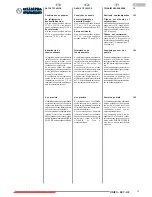
GB
F
D
22
I
Scelta della posizione dove
installare il climatizzatore
La posizione di installazione deve
essere scelta a ridosso di una pa-
rete comunicante con l’esterno.
Avvertenza: Una volta individuata,
secondo i criteri precedentemente
esposti, la corretta posizione per
l’installazione occorre verificare
che nei punti dove avete intenzione
di praticare i fori non vi siano strut-
ture od impianti (travi , pilastri, tu-
bazioni idrauliche, cavi elettrici
ecc.) che impediscano l’esecuzio-
ne dei fori necessari all’installazio-
ne.
Controllate ancora una volta che
non sussistano ostacoli alla libera
circolazione dell’aria attraverso i
fori che andrete a praticare (piante
e relativo fogliame, doghe di
rivestimento, persiane, grate o
griglie troppo fitte ecc.).
Dimensioni e caratteristi-
che del locale dove installa-
re il climatizzatore
Prima di installare il climatizzatore è
indispensabile procedere ad un
calcolo dei carichi termici estivi (ed
invernali nel caso di modelli con
pompa di calore) relativi al locale
interessato.
Più questo computo è corretto e più
il prodotto assolverà pienamente la
sua funzione.
Per l’esecuzione dei calcoli dovete
riferirvi direttamente alle normative
in vigore (UNI rif. Legge 10/91) o a
tabelle, sia stampate che informati-
che, estrapolate dalle stesse norme.
Per applicazioni particolarmente
importanti Vi consigliamo di rivolgerVi
a studi termotecnici specializzati.
2.2.1
2.2.2
Choice of best position for
installing the air conditioner
The air conditioner must be installed
on a wall that communicates with the
outside.
Caution: After determining the best
place for installation as described
above, check to make sure that the
wall can be drilled in that point
without interfering with other
structures or installations (beams,
piers, pipes, wires, etc.).
Check again to make sure there are
no obstacles to air circulation
through the holes to be drilled due to
plants and their leaves, slats or
panelling, blinds, gratings or grids
too dense, etc.).
Dimensions and features of
site where air conditioner is
installed
Before installing the air conditioner,
it is essential to make an accurate
calculation of the heat load in
summer (and cold load in winter for
models with heating pump) at the
site of installation.
The more accurate this calculation
is made the better the air conditioner
will be able to do its job.
To make these calculations, refer
directly to the regulations in effect
(UNI ref. Law 10/91) or to the tables,
both printed and computerized, based
on those regulations.
For particularly significant
applications, we recommend
contacting expert heating engineers.
Choix de la position où
installer le climatiseur
La position de l'installation doit être
choisie sur un mur communiquant
avec l'extérieur.
AVERTISSEMENT: Une fois
localisée la position correcte pour
l'installation, selon les critères
précédemment exposés, il vaut
vérifier qu'à l'endroit où vous avez
l'intention de percer des trous, il n'y
ait pas de structures ou
d'installations (poutres, piliers,
tuyauteries hydrauliques, câbles
électriques, etc ...) qui empêchent
l'exécution des trous nécessaires à
l'installation.
Contrôler encore une fois qu'il n'y
ait pas d'obstacles à la libre
circulation de l'air à travers les trous
que vous allez pratiquer (arbres et
leur feuillage, lambris, persiennes,
grillages ou grilles trop serrés, etc...).
D i m e n s i o n s e t
caractéristiques de la pièce
où le cli matiseur doit être
installé
Avant l'installation du climatiseur, il
est indispensable de procéder à un
calcul des charges thermiques d'été
(et hivernale en cas de modèles
avec pompe à chaleur) relatives à la
pièce concernée.
Plus ce calcul est correct et plus
votre climatiseur remplira sa fonction.
Pour l'exécution des calculs, vous
devrez vous référer directement aux
règlementations en vigueur (UNI réf.
Loi 10/91) ou aux tableaux, aussi
bien imprimés qu'informatiques,
extrapolés de ces mêmes normes.
Pour des applications
particulièrement importantes, nous
vous conseillons de vous adresser à
des bureaux d'études thermo-
techniques spécialisés.
Wahl der Stelle, an der das
Klimagerät installiert
werden soll
Das Gerät ist an einer zur Außenseite
des Gebäudes gerichteten Wand zu
installieren.
Hinweis: Nachdem unter
Berücksichtigung der zuvor
erläuterten Kriterien die Stelle, an der
das Klimagerät installiert werden
soll, gewählt wurde, ist zu überprüfen,
ob sich an der zu bohrenden Stelle in
der Wand Stahlträger, Wasserrohre,
Abwasserleitungen, elektr. Kabel
o.ä. befinden, die eine Bohrung
verhindern.
Nach der Erstellung der beiden
Bohrungen ist zu überprüfen, ob der
Außenluftansaug und die
Rückführung der Luft nach außen
nicht durch blattreiche Pflanzen,
F a s s a d e n v e r k l e i d u n g e n ,
Fensterläden o.ä. behindert wird.
Abmessungen und
Eigenschaften des Raums, in
dem dem das Klimagerät
installiert wird
Vor der Installation des Klimagerätes
ist eine Berechnung der benötigten
Kühlleistung für den Sommer (für den
Winter nur bei Modellen, die mit einer
Wärmepumpe ausgestattet sind)
bezüglich des betreffenden Raums
durchzuführen.
Je genauer diese Berechnung ist, de-
sto effizienter ist die Arbeitsweise
des Gerätes. Für die Durchführung
der Berechnungen hat man sich auf
die Vorschriften der geltenden
Richtlinien (UNI Gesetz Nr. 10/91)
oder auf die Tabellen (auf Ausdrucken
oder Datenträgern), die ebenfalls in
den Richtlinien enthalten sind, zu
beziehen.
Im Falle von besonders komplexen
Installationen ist es empfehlenswert,
sich an kompetente Fachkräfte
(Wärmetechniker) zu wenden.
3
1
2
Downloaded from AC-Manual.com Manuals
Содержание Gamma Sky
Страница 110: ...Downloaded from AC Manual com Manuals...
















































